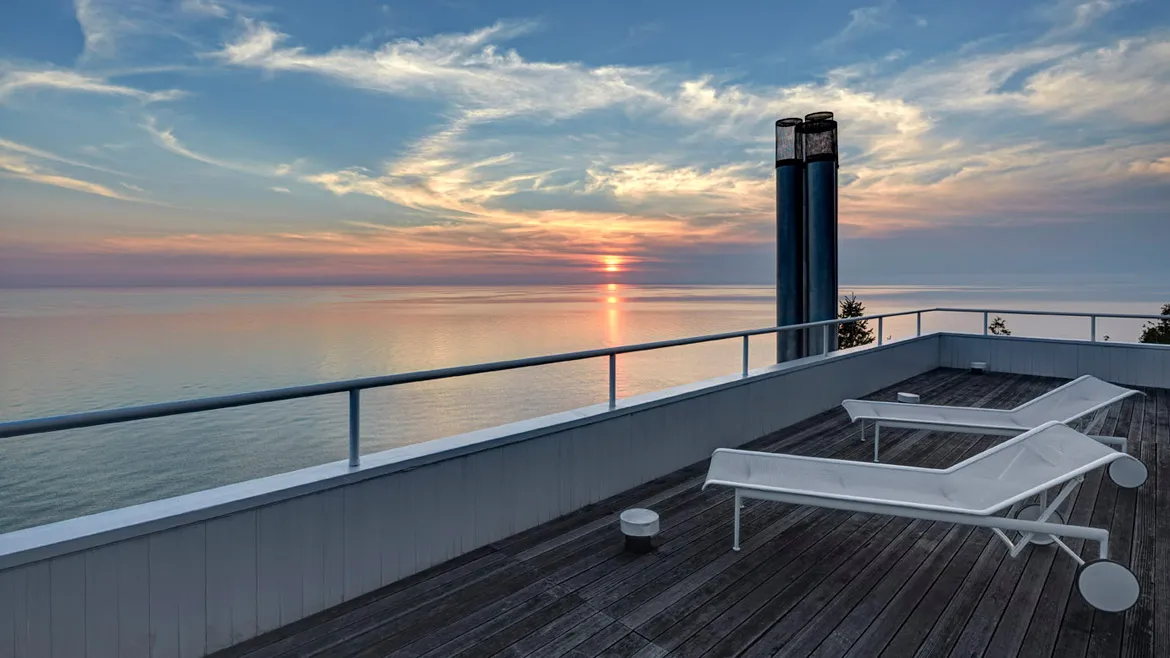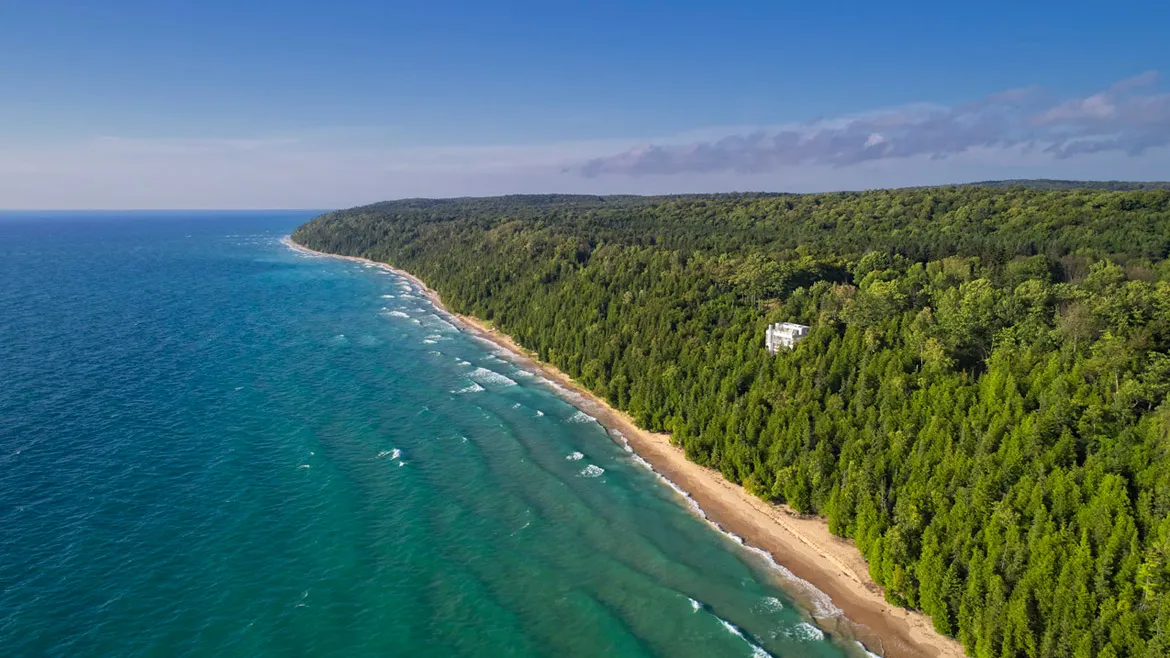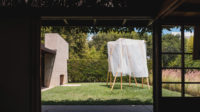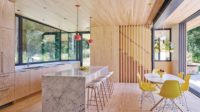Modernist House Celebrates 50th Anniversary with Completion of Multiyear Renovation

The exterior's original redwood beams, in both the bridge and the exterior staircase, have been replaced. Photo © James Haefner

The renovated Douglas House by Richard Meier (completed in 1973) in Harbor Springs, Michigan, sits on a densely forested shore of Lake Michigan. Photo © James Haefner






Architects & Firms
The sheer beauty of Richard Meier’s Douglas House in Harbor Springs, Michigan, stunned the profession when it first appeared on the cover of Progressive Architecture in 1973. The blazing white, spatially complex and porous four-story structure—looking like an apparition on a steep, forested hillside facing Lake Michigan—consolidated Meier’s reputation as a leading Modernist. With the Douglas House and its forerunner, the Smith House (1967) in Connecticut, among others, Meier moved beyond the initial influence of Le Corbusier and embarked on a major American career. For the following decades, until his ultimate retirement, under a cloud, in 2021, he would develop the vocabulary he established in these early projects.
But the problem with crisp, white, pristine houses is that their impact depends on remaining crisp, white and pristine. Meier’s buildings age like any other, subject to time, weather and gravity. Aging, however, doesn’t suit them as it might, say, a Richardsonian masonry structure enhanced by the patina of time. Changing home ownerships can also take its toll. After the Douglas family sold the Harbor Springs house, new owners wallpapered the interiors, and under a third owner, it suffered years of delayed maintenance. Meier’s buildings may be born as perfect Platonic ideals, but the perfection requires regular care, even upgrades.
In 2007, when Mike McCarthy and Marcia Myers, both retired former executives at Procter & Gamble, were looking for a summer house—on an ocean site somewhere, they thought—she chanced on a promising ad in the Wall Street Journal for the 3,200 square-foot, four-story, five-bedroom Douglas house. They convinced themselves that Lake Michigan was, effectively, an ocean, but neither had any idea about the house’s architectural stature. Nor had they heard of Meier. The house landed in their life, but not as a Modernist classic done by a famous architect.

Douglas House's porous white facade sticks out amongst the surrounding greenery. Photo © James Haefner
They would soon get the memo: the faithful arrived, knocking at their door. “People started coming and writing books and taking photographs. Some older people had tears in their eyes,” Myers recalls, adding that if “just owning the house is bringing happiness and enjoyment to so many different types of people,” they would start thinking of themselves as stewards of a cultural asset rather than as just owners of a vacation house.
Not that fulfilling that promise was simple. By the time they had bought the house, a litany of problems had compromised the wood-framed, painted redwood-clad structure. The bridge from the road to the house, structured in redwood, sagged; condensation inside walls had rotted framing; double-glazing installed by previous owners had compromised the proportions of the facade, and the HVAC system was inadequate. On some days, the condensation caused the house to rain inside.
For 15 years, they tackled one problem at a time, mainly during the fall and spring, on the shoulders of their summer vacation (they mostly live in Cincinnati but spend winters at another house in Arizona). Sometimes they cohabited the house with workmen. McCarthy is an engineer whose father had been, among other things, a cabinetmaker, and he enjoyed running the project—the challenge of the many parts becoming an architectural whole. “I had fun figuring out how to make it right, how to make it a little better than it was,” he says.
Meier and New York architect Tod Williams, who had worked for Meier in the 1970s and was project architect of the house, living near the Harbor Springs site, occasionally consulted with McCarthy and Myers during the restoration. The Meier office provided the original construction drawings as a road map. Meier advised that surfaces mattered: he blessed structural upgrades, like replacing the redwood structure of the sagging bridge with steel, so long as the outward appearance remained as originally intended. The couple worked with a local general contractor, Dave McBridge, who helped find the crucial master builders: the quality of reconstruction depended directly on the skills they would bring to a demanding architectural thoroughbred. McCarthy problem-solved with craftsmen in a hands-on collaboration.

1

2
In addition to renovating the exterior including the the redwood beams and the thin, free-standing chimney (2), the couple reassembled much of the house's original furniture including Le Corbusier and Mies van der Rohe chairs and a Meier dining table (1). Photos © James Haefner
The restoration is now, after more than a dozen years, complete, and Meier’s villa is again pristine. No sagging anywhere. No interior precipitation. Solar overload controlled. The owners replaced the redwood beams in both the bridge and the exterior staircase, which projects acrobatically into thin air with steel, and rebuilt the free-standing, four-story chimney stack and base. Over the years, the couple have even reassembled the original furniture: Corb and Mies chairs, a Meier dining table and sofa. They retained a splendid rug that the previous owners had commissioned, duplicating a tapestry by Le Corbusier. McCarthy and Myers came to realize that the interior and exterior were a gesamtkunstwerk, and that they could neither add nor subtract anything. Even a painting would throw off the balance of parts, as designed in Meier’s tightly conceived ink drawings. For all its dazzling complexity and apparent liberties, the geometric control underlying the design was highly disciplined, elaborate to a point of aesthetic saturation.
“These windows line up with those windows,” says McCarthy, pointing out the alignments with the sensibility of an engineer. “Everything's in the right place. There's nothing that's ugly. It's a well-organized aesthetic, which I like and need. I'm comfortable here.”
As beautiful as the house is as an object, and as complete as an aesthetic mechanism, the form acts as a threshold into nature, the whiteness an agent of luminosity. The design may thrum with Cartesian coordination, but, on the stepladder principle, it delivers the couple directly to the forest, lake, and light. Entry starts at the bridge on the fourth floor, mostly an outdoor roof terrace, and then leads down to cabin-like bedrooms on the third floor, and to the living room and primary bedroom on the second. The kitchen and dining room, with a second primary bedroom, are on the first. Bedrooms and kitchen form an opaque block of rooms facing the uphill side of the property, while the airy, spacious living area, in a vertiginously vertical, double-height space, faces the lake, with the dining area below.

3

4
The double-height living room includes an original Meier sofa (3) and has a panoramic view of Lake Michigan (4). Photos © James Haefner
"On the roof, you’ve got this great view of the lake and sky, complete with wheeling eagles, and then you work your way downstairs, and each level gives you a different perspective,” says Myers. “You get more into the trees until down at the bottom you're in the tree house, and it's just totally different.”
The house they originally intended as a summer house with a water view, in fact, still functions as a vacation retreat, but it has also become a mission. McCarthy, 75, and Myers, 72, plan to establish a foundation as a legacy to protect the house, eventually to be lived in by a knowledgeable custodian who will make it accessible to the public and professionals in perpetuity.







